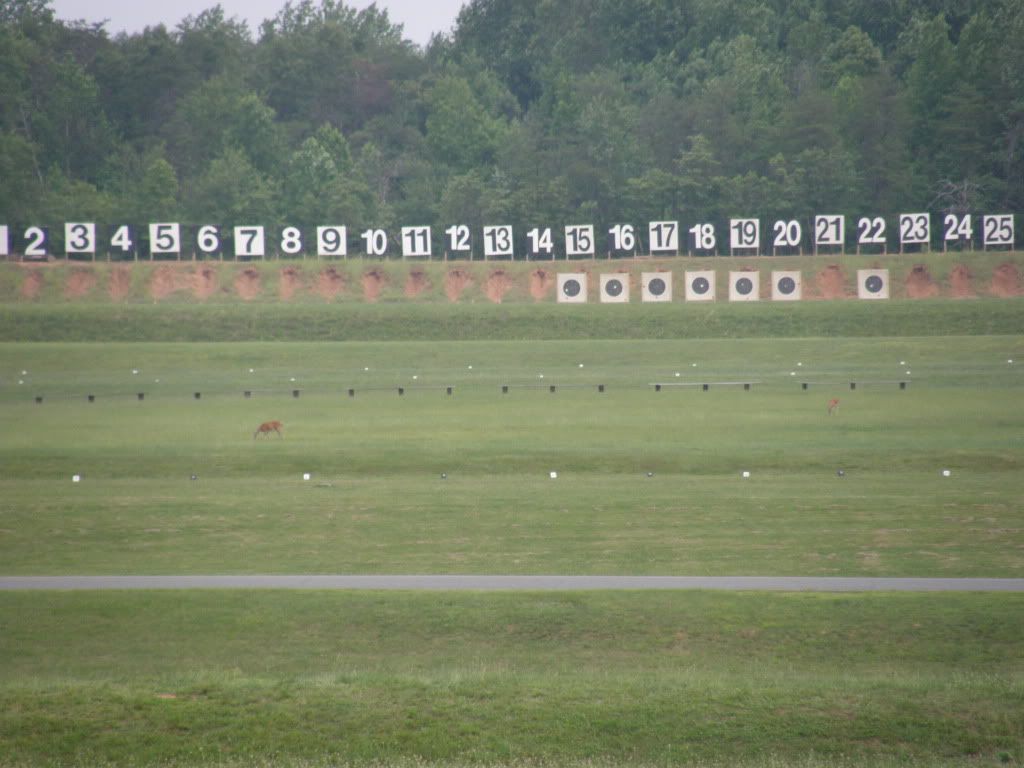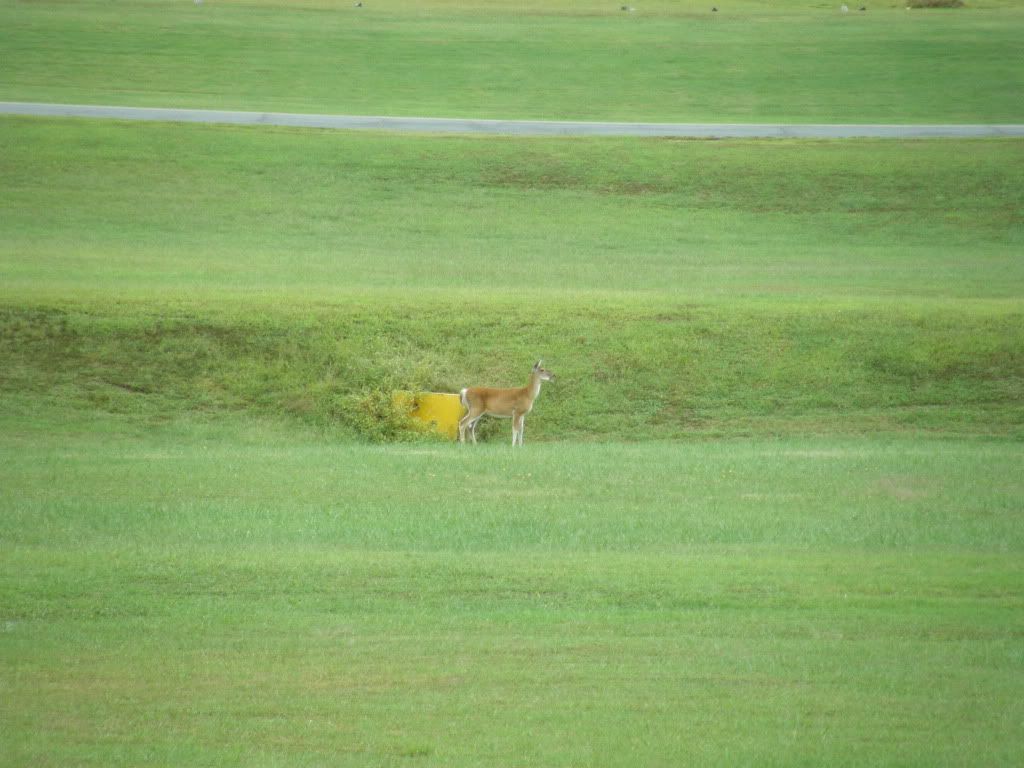Ive seen a few while shooting there...........
AP
QUANTICO, Virginia - Call it a playground for Bambi and G-Men, where imaginary criminals are hunted and deer are the spectators.
The 547-acre FBI Academy, where some of America's best marksmen fire off more than 1 million bullets every month, happens to be one of the safest places for deer during hunting season.
The property on the Marine Corps base in Quantico, Va., is home to some of the FBI's most elite forces and training programs as well as a de facto wildlife refuge where deer, fox, wild turkeys, groundhogs and vultures roam fearless and free.
In recent years, a black bear was spotted running across a parking lot, and a groundhog cornered an FBI agent coming out of the cafeteria, hoping to score some human food, FBI spokesman Kurt Crawford said. Turkey vultures are often seen perched atop the 500,000 square foot national crime lab where the FBI analyzes evidence, including the remains of the former al-Qaida leader in Iraq.
The wild animals are as much a fixture at the academy as the hostage rescue team and criminal profilers.
The most common furry friends on the sprawling campus some 30 miles outside Washington are the deer, a regular at the shooting ranges, driving courses and physical training trails.
On a December afternoon, deer grazed above one of the academy's 16 practice shooting ranges. They stood just 15 feet away from the paper targets. Nearby, shots popped loudly from a Colt M4 Carbine rifle, and the white-tailed deer did not flinch.
"They're pretty immune to the sound," said Sean Boyle, supervisory special agent bomb technician and principal firearms instructor for the Critical Incident Response Group based at the academy. The deer typically graze on top of the berm, about 15 feet away from the targets and rarely go directly in the line of fire. Boyle said he doesn't recall an instance where a deer was shot accidentally.
"It's like they think, 'We've pushed the limit for this far, and all our generations have pushed the limit for this far,'" Boyle said. "They're just so docile around here. They don't know what a gun is."
The Virginia Department of Game and Inland Fisheries does not keep direct tabs on the deer population at the FBI academy, but a spokeswoman said statewide the deer population has remained about the same over the past decade, partly because of regulated hunting. Licensed deer hunters are allowed on parts of the Marine Corps base but not at the academy where the FBI does not hunt its animals.
At the FBI Academy, the deer have even become part of the training in some of the driving courses, said Tim Moles, the supervisory special agent who oversees the Tactical and Emergency Vehicle Operations Center, where recruits learn to avoid crashing their cars and conduct surveillance without being spotted.
The deer are convenient when recruits learn to avoid collisions, Moles said. "There's times when it seems like they're playing chicken with us," Moles said. "We respect them because they can do damage. We'd rather avoid all deer stories in this end of the academy."
For the most part, the deer have stayed out of trouble. Twice, however, deer have eaten freshly-planted pansies at the academy's 9/11 memorial courtyard, Crawford said. Eventually a fence was built to keep the flowers off limits.
Deer have been known to interrupt physical training, too.
"We've had the deer walk across the middle of the track during the 300-meter sprint," said Susann Dreiling, unit chief of the academy's physical training unit.
To become an agent, recruits must pass a physical fitness test. They are scored on how fast they can run and how many push-ups and sit-ups they perform. Sometimes, training will involve running a quarter-mile path along the lake area of the academy, stopping for push-ups, running some more and breaking to box, Dreiling said.
During these exercises, a mother and her fawns are often close by.
"They just stand there and watch as if they're evaluating them," Dreiling said, "just like the instructors are."
AP
QUANTICO, Virginia - Call it a playground for Bambi and G-Men, where imaginary criminals are hunted and deer are the spectators.
The 547-acre FBI Academy, where some of America's best marksmen fire off more than 1 million bullets every month, happens to be one of the safest places for deer during hunting season.
The property on the Marine Corps base in Quantico, Va., is home to some of the FBI's most elite forces and training programs as well as a de facto wildlife refuge where deer, fox, wild turkeys, groundhogs and vultures roam fearless and free.
In recent years, a black bear was spotted running across a parking lot, and a groundhog cornered an FBI agent coming out of the cafeteria, hoping to score some human food, FBI spokesman Kurt Crawford said. Turkey vultures are often seen perched atop the 500,000 square foot national crime lab where the FBI analyzes evidence, including the remains of the former al-Qaida leader in Iraq.
The wild animals are as much a fixture at the academy as the hostage rescue team and criminal profilers.
The most common furry friends on the sprawling campus some 30 miles outside Washington are the deer, a regular at the shooting ranges, driving courses and physical training trails.
On a December afternoon, deer grazed above one of the academy's 16 practice shooting ranges. They stood just 15 feet away from the paper targets. Nearby, shots popped loudly from a Colt M4 Carbine rifle, and the white-tailed deer did not flinch.
"They're pretty immune to the sound," said Sean Boyle, supervisory special agent bomb technician and principal firearms instructor for the Critical Incident Response Group based at the academy. The deer typically graze on top of the berm, about 15 feet away from the targets and rarely go directly in the line of fire. Boyle said he doesn't recall an instance where a deer was shot accidentally.
"It's like they think, 'We've pushed the limit for this far, and all our generations have pushed the limit for this far,'" Boyle said. "They're just so docile around here. They don't know what a gun is."
The Virginia Department of Game and Inland Fisheries does not keep direct tabs on the deer population at the FBI academy, but a spokeswoman said statewide the deer population has remained about the same over the past decade, partly because of regulated hunting. Licensed deer hunters are allowed on parts of the Marine Corps base but not at the academy where the FBI does not hunt its animals.
At the FBI Academy, the deer have even become part of the training in some of the driving courses, said Tim Moles, the supervisory special agent who oversees the Tactical and Emergency Vehicle Operations Center, where recruits learn to avoid crashing their cars and conduct surveillance without being spotted.
The deer are convenient when recruits learn to avoid collisions, Moles said. "There's times when it seems like they're playing chicken with us," Moles said. "We respect them because they can do damage. We'd rather avoid all deer stories in this end of the academy."
For the most part, the deer have stayed out of trouble. Twice, however, deer have eaten freshly-planted pansies at the academy's 9/11 memorial courtyard, Crawford said. Eventually a fence was built to keep the flowers off limits.
Deer have been known to interrupt physical training, too.
"We've had the deer walk across the middle of the track during the 300-meter sprint," said Susann Dreiling, unit chief of the academy's physical training unit.
To become an agent, recruits must pass a physical fitness test. They are scored on how fast they can run and how many push-ups and sit-ups they perform. Sometimes, training will involve running a quarter-mile path along the lake area of the academy, stopping for push-ups, running some more and breaking to box, Dreiling said.
During these exercises, a mother and her fawns are often close by.
"They just stand there and watch as if they're evaluating them," Dreiling said, "just like the instructors are."



